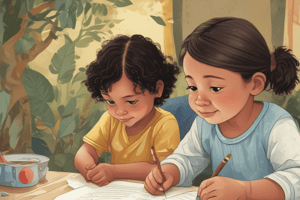Podcast
Questions and Answers
What is the primary purpose of the Early Childhood Environment Rating Scale?
What is the primary purpose of the Early Childhood Environment Rating Scale?
- To assess the cognitive development of children
- To evaluate the quality of staff in early childhood education environments
- To promote social development in early childhood education
- To measure the quality of early childhood education environments (correct)
What is one of the strategies for supporting children's oral language development?
What is one of the strategies for supporting children's oral language development?
- Providing language learning apps to children
- Reading stories out loud to children and asking questions about the story (correct)
- Encouraging children to speak in front of their peers
- Creating a diverse library with books on science and technology only
What is the benefit of using puppet shows to develop children's listening skills?
What is the benefit of using puppet shows to develop children's listening skills?
- It helps children to develop their social skills
- It helps children to understand emotions, tones, and contexts within spoken language (correct)
- It helps children to develop their cognitive skills
- It helps children to develop their problem-solving skills
What is one of the key elements of creating a diverse library to support children's oral language development?
What is one of the key elements of creating a diverse library to support children's oral language development?
What is the benefit of exposing children to books that reflect diverse perspectives and experiences?
What is the benefit of exposing children to books that reflect diverse perspectives and experiences?
What is one way to enhance children's social and emotional development through literature?
What is one way to enhance children's social and emotional development through literature?
What is the purpose of setting up listening centers in the classroom?
What is the purpose of setting up listening centers in the classroom?
How can flannel boards and picture card games support language development?
How can flannel boards and picture card games support language development?
What is one way to use puppets to support language development?
What is one way to use puppets to support language development?
What is the benefit of incorporating sensory experiences into language learning?
What is the benefit of incorporating sensory experiences into language learning?
Flashcards are hidden until you start studying
Study Notes
The Early Childhood Environment Rating Scale
- A comprehensive assessment tool to measure the quality of early childhood education environments
- Evaluates environments that support children's development and learning, including oral language development
Supporting Oral Language Development
- Staff-initiated receptive language activities to improve children's listening and understanding skills
- Examples:
- Reading stories out loud to promote language skills and understanding
- Puppet shows to develop listening skills and interpret emotions, tones, and contexts
- Flannel boards to link spoken words to visual elements and enhance vocabulary and concepts
Creating a Diverse Library
- A strategy to support children's oral language development
- Key elements:
- Building a library with a wide range of topics and diverse cultures, languages, and abilities
- Aligning books with classroom themes to reinforce learning
- Providing engaging and informative books to nurture a love for reading
- Fostering empathy, inclusivity, and social-emotional development
Offering Materials for Language Development
- A strategy to support children's oral language development
- Examples:
- Listening centers with audio books and recordings to focus on spoken language and vocabulary
- Flannel board stories and picture card games to practice storytelling and vocabulary
- Puppets for child use to practice dialogues and conversations
- Sensory experiences to encourage descriptive language and communication
Studying That Suits You
Use AI to generate personalized quizzes and flashcards to suit your learning preferences.




